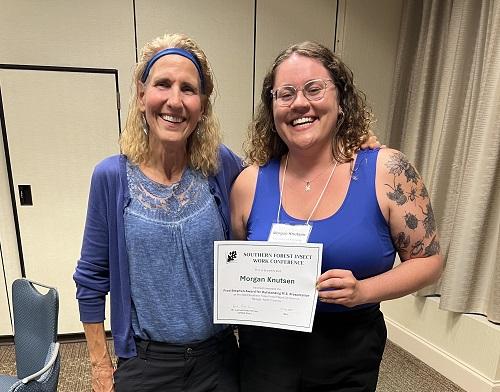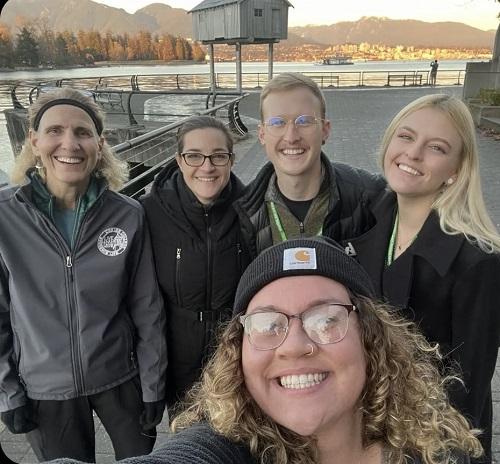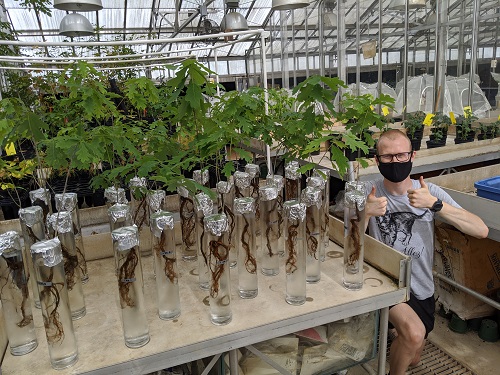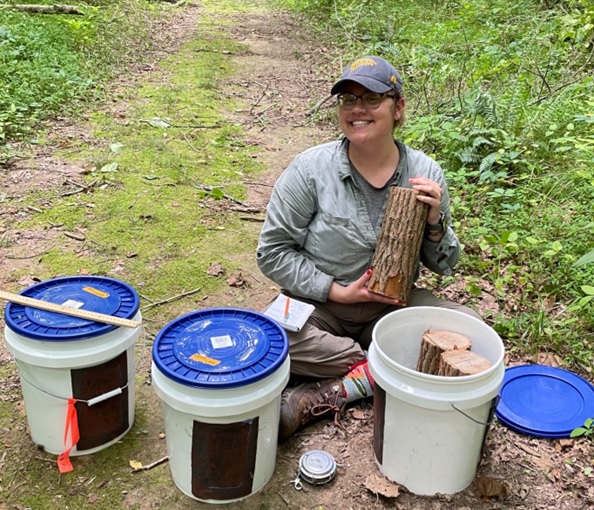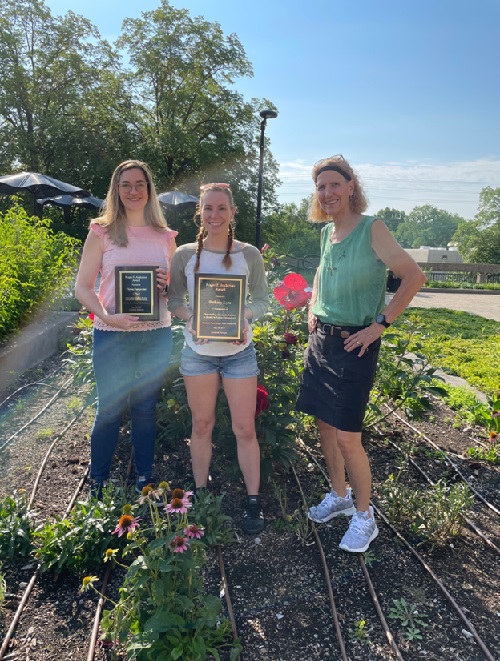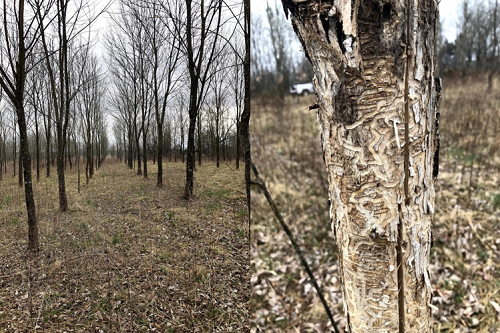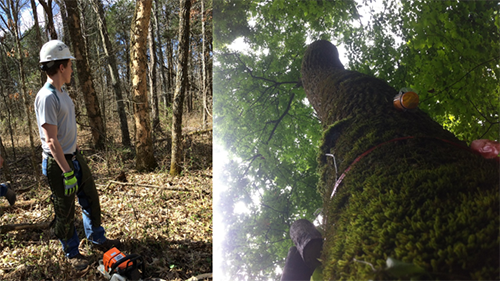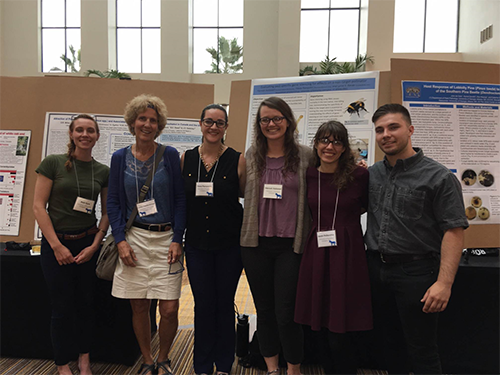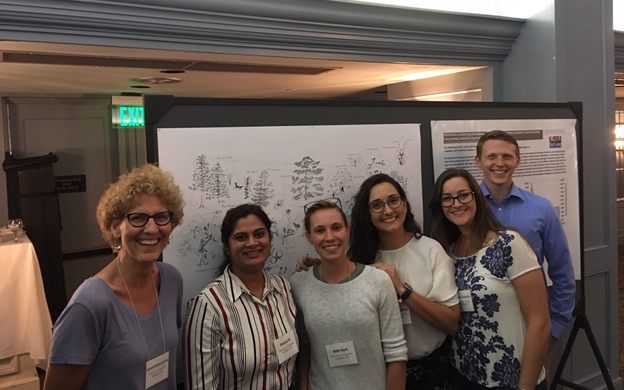Forest Entomology at the University of Kentucky
Forest Entomology at the University of Kentucky
Forest Entomology at the University of Kentucky
Dr. Lynne K. Rieske-Kinney Laboratory
Return to Dr. Lynne K. Rieske-Kinney homepage
Congratulations to Morgan Knutsen! Award recipient for best oral presentation, MS division, at the Southern Forest Insect Work Conference (June 2023)!
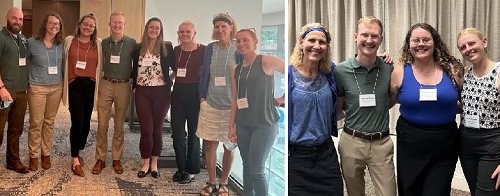
Lab Members and alumni at the Southern Forest Insect Work Conference, Lexington, KY, June 2022 and Raleigh, NC, June 2023
Morgan Knutsen, 2023 Southern Forest Insect Work Conference awardee, June 2023
Current lab projects
• Gene silencing in forest pests.
We’re evaluating various aspects of utilizing RNA interference to induce gene silencing for forest pest suppression, focusing on wood boring beetles and bark beetles. The emerald ash borer, Agrilus planipennis (EAB), is an exotic, aggressive, tree-killing beetle that has caused the loss of millions of ash trees in urban and wildland forests of the US. The endemic southern and mountain pine beetles, Dendroctonus frontalis (SPB) and D. ponderosae (MPB), and the six-spined engraver, Ips calligraphus, undergo population outbreaks that can lead to landscape-scale tree mortality and catastrophic losses. Finally, exotic invaders such as the redbay ambrosia beetle, Xyleborus glabratus, vector potentially lethal pathogens that cause extensive tree mortality. Innovative pest management strategies are needed to help mitigate these challenges.
We’ve shown that RNA interference (RNAi) can cause rapid and extensive mortality in these beetles; we are now:
- Evaluating optimal gene selection
- Demonstrating specificity with mortality assays, gene expression and in silico analyses in model insects and in pest associates.
- Evaluating potential delivery methods, investigating the potential for single-tree and forest-wide approaches.
EAB is an invader of unprecedented scope and magnitude, affecting urban and wildland forests and continuing to expand its invaded range in North America. Bark and ambrosia beetles are expanding their geographic range in response to our changing climate, causing extensive forest mortality and disrupting the ecosystem services that contribute to global sustainability. My lab is contributing workable solutions to these forest health crises.
Interested? email me at Lrieske@uky.edu.
Lab members at the Entomological Society of America annual meeting, Vancouver, British Columbia, November 2022
Current Lab Associates
Mary Wallace
PhD, May 2023 (projected) [Arrived Aug 2019]. mary.wallace@uky.edu. Exploring the potential for managing Scolytinae using RNAi.
Mary’s awards:
- First Place, Oral presentation, Southern Forest Insect Work Conference, June 2022.
- Publication Acceptance Scholarship, UK Dept of Entomology, December 2021.
- President’s Prize, First Place, Oral presentation, Entomological Society of America, November 2021.
- Publication Submission Scholarship, UK Dept of Entomology, June 2021.
- First Place, Oral presentation, PhD division, North American Forest Insect Work Conference, May 2021.
- Mentor Recognition Award (GR-10), UK Graduate Student Congress, May 2021.
- 2019-2020 Cralle Foundation/Joan Cralle Day Fellowship, University of Kentucky Graduate School. $15000. July 2019.
Mary’s publications:
- Wallace, MC, LK Rieske. 2023. Ingestion of species-specific dsRNA causes gene knockdown and mortality in the forest pest, Ips calligraphus. Forests 14(2), 422; https://doi.org/10.3390/f14020422
- Hollowell, HM, MC Wallace, and LK Rieske. 2022. The trigger for RNA interference to silence essential genes in southern pine beetle, Dendroctonus frontalis, demonstrates no effect on pine-associated nontarget insects. Agricultural and Forest Entomology 25, 272-284. https://doi.org/10.1111/afe.12550.
- Wallace, MC, LK Rieske. 2021. Validation of reference genes for quantitative PCR in the forest pest, Ips calligraphus. Scientific Reports. https://doi.org/10.1038/s41598-021-02890-z. Link.
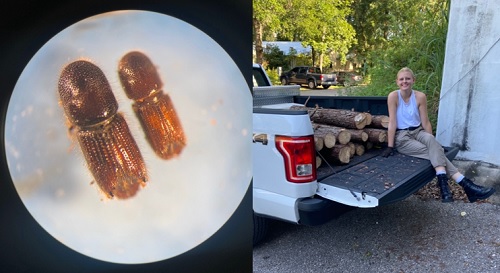
Evaluating Ips for gene silencing requires a ready source of beetles, November 2019

Zachary Bragg
PhD May 2023 (projected) [Arrived Aug 2019]. zachary.bragg@uky.edu. Uptake, movement, response, and production of double stranded RNA developed for forest insect pest suppression delivered through woody plant tissues.
Zach’s awards:
- Publication Acceptance Scholarship, UK Dept of Entomology, January 2022.
- President’s Prize, First Place, Oral presentation, Entomological Society of America, November 2021.
- Publication Submission Scholarship, UK Dept of Entomology, June 2021.
- Second Place, Oral presentation, MS division, North American Forest Insect Work Conference, May 2021.
- President’s Prize, First Place, Oral presentation, Entomological Society of America, November 2020.
- Second Place, Oral presentation, MS division, Ohio Valley Entomological Association, October 2019.
Zach’s publications:
- Bragg ZA, LK Rieske. Submitted. Identification of RNAi-related genes and transcriptomic response of loblolly pine seedlings exposed to southern pine beetle dsRNA. Submitted to: Tree Genetics & Genomes; August 2023.
- Bragg ZA, LK Rieske. Spatial distribution and retention in loblolly pine seedlings of exogenous dsRNAs applied through roots. International Journal of Molecular Sciences. 23, 9167. https://doi.org/10.3390/ijms23169167. Link.
- Bragg ZA, LK Rieske. 2022a. Feasibility of systemically applied dsRNAs for pest-specific RNAi-induced gene silencing in white oak. Frontiers in Plant Science. 13. https://doi.org/10.3389/fpls.2022.830226. Link.
Evaluating in planta uptake of dsRNAs that induce gene silencing, 2020

Morgan Knutsen
MS, August 2023; PhD Dec 2027 (projected) [Arrived Aug 2021] Morgan.knutsen@uky.edu.
PhD: Evaluating a fungal associate transformed to induce gene silencing as a delivery mechanism for dsRNA in southern pine beetle; MS: Investigating the feasibility of RNAi-mediated gene silencing in the redbay ambrosia beetle.
Morgan’s awards:
- Publication Acceptance Scholarship, UK Department of Entomology, Sep 2023.
- Best MS Oral Presentation, Southern Forest Insect Work Conference, July 2023.
- Publication Submission Scholarship, UK Department of Entomology, July 2023.
- First place, Oral presentation, Southern Forest Insect Work Conference, June 2022.
Morgan’s publications:
- Knutsen MC, LK Rieske. In prep. Evaluating the feasibility of RNAi-induced gene silencing to induce mortality in the redbay ambrosia beetle.
- Knutsen MC, LK Rieske. 2023. Presence of the causal agent of laurel wilt disease in sassafras-associated insects. Environmental Entomology, nvad099. https://doi.org/10.1093/ee/nvad099
Field collecting laurel wilt disease infected sassafras assures a ready supply of redbay ambrosia beetles for RNAi research. May, 2022

Patrick Simon
MS (non-thesis) [Arrived Aug 2021] patrick.simons@uky.edu. Practicum topic: Assessing effects of Laricobius releases on hemlock health. [currently Forest Health Specialist, Maryland Forest Service].
Maddy Richmond, Aug 2025 (projected) [Arrived Aug 2023] madeline.richmond@uky.edu. Field application of dsRNA designed to induce gene silencing and mortality in emerald ash borer.
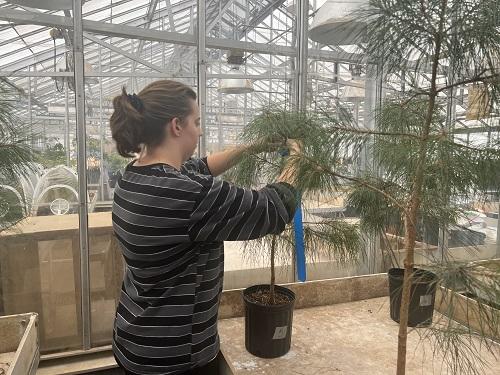
Research occurs in the lab, in the greenhouse, and in the field

Some Former Lab Associates
2022
Bethany Kyre
PhD, Dec 2022. bethkyre@gmail.com. Gene silencing in Dendroctonus bark beetles. [Currently Forest Entomologist, USDA Forest Service]
Beth’s awards:
- Research Activity Award, University of Kentucky (UK), College of Agriculture, Food & Environment, January 2021.
- Conference Award, UK Graduate Student Congress, November 2020.
- President’s Prize, Second Place, Oral presentation, Entomological Society of America, November 2019.
- Barnhart Fund for Excellence, UK College of Agriculture, Food & Environment, April 2019, April 2020.
- First Place, Oral presentation, PhD division, Ohio Valley Entomological Association, October 2018, 2019.
- Roger F. Anderson Award for Graduate Student Excellence, Southern Forest Insect Work Conference, Savanna, GA, July 2019.
- First Place, Oral presentation, PhD division, Southern Forest Insect Work Conference, Savanna, GA, July 2019.
- People’s Choice, 3MT Competition, UK CAFE, April 2019.
- Publication Acceptance Scholarship, UK Dept of Entomology, March 2019, May 2020, July 2022.
- Publication Submission Scholarship, UK Dept of Entomology, August 2018.
Beth’s Publications:
- Kyre BR, JR Dupuis, G Zúñiga, LK Rieske. 2023. Variation in RNAi sensitivity in the southern pine beetle, Dendroctonus frontalis. Biological Journal of the Linnean Society short communication, 1-8. https://doi.org/10.1093/biolinnean/blad126
- Kyre BR, LK Rieske. 2022. Using RNAi to silence heat shock protein has congeneric effects in North America’s Dendroctonus bark beetles. Forest Ecology and Management 520, 120367. https://doi.org/10.1016/j.foreco.2022.120367
- Kyre BR, BJ Bentz, LK Rieske. 2020. Susceptibility of mountain pine beetle (Dendroctonus ponderosae Hopkins) to gene silencing through RNAi provides potential as a novel management tool. Forest Ecology and Management 473, 118322. https://doi.org/10.1016/j.foreco.2020.118322
- Kyre BR, TB Rodrigues, LK Rieske. 2019. RNA interference and validation of reference genes for gene expression analyses using RT-qPCR in southern pine beetle, Dendroctonus frontalis. Scientific Reports 9, 5640. DOI:10.1038/s41598-019-42072-6. Link.
Roger F. Anderson Award winners, 2022 (l.) and 2019 (r.), Southern Forest Insect Work Conference
Flávia Pampolini
PhD, Dec 2022. flapampo@gmail.com. Gene silencing using RNAi in emerald ash borer: The path to deployment. [Currently Research Scientist, Molecular Entomology, private industry].
Flávia’s awards:
- Roger F. Anderson Award for Graduate Student Excellence, Southern Forest Insect Work Conference, Lexington, KY, June 2022.
- Professional Development Award, UK Graduate Student Congress, Dec 2021
- President’s Prize, Second Place, Oral presentation, Entomological Society of America, November 2021.
- Richards Graduate Student Research Activity Award (UK CAFE). October 2019, November 2020.
- Publication Acceptance Scholarship, UK Dept of Entomology, May 2020, December 2020.
- Publication Submission Scholarship, UK Dept of Entomology, November 2019.
- Graduate Student Travel Award. October 2018.
Flávia’s publications:
- Pampolini F, Rieske LK. 2023. Foliar application of dsRNA to induce gene silencing in emerald ash borer: Systemic distribution, persistence, and bioactivity. Forests 14, 1853. Link.
- Tull AR, H Gladfelter, F Pampolini, LK Rieske, CD Nelson, S Merkle. 2022. Development of a new genetic transformation system for white and green ash using embryogenic cultures. Forests DOI: 10.3390/f13050671. Link
- Pampolini F, LK Rieske. 2020. Emerald ash borer specific gene silencing has no effect on non-target organisms. Special Issue: New Applications of Insecticidal RNAi, Frontiers in Agronomy 2:608827. doi: 10.3389/fagro.2020.608827. Link.
- Pampolini, F, TB Rodrigues, RS Leelesh, T Kawashima, LK Rieske. 2020. Confocal microscopy provides visual evidence and confirms the feasibility of dsRNA delivery to emerald ash borer through plant tissues. Journal of Pest Science DOI: 10.1007/s10340-020-01230-w. Link.
EAB is causing widespread loss of ash. LaRue Co., March 2021
2021
Hannah Hollowell
MS, Aug 2021. Evaluating the specificity of southern pine beetle gene silencing. [currently Forest Health Specialist, Tennessee Division of Forestry].
Hannah’s awards:
- First Place, Oral presentation, MS division, North American Forest Insect Work Conference, May 2021.
- President’s Prize, First Place, Oral presentation, Entomological Society of America, November 2020.
Hannah’s publications:
- Hollowell, HM, MC Wallace, and LK Rieske. 2022. The trigger for RNA interference to silence essential genes in southern pine beetle, Dendroctonus frontalis, demonstrates no effect on pine-associated nontarget insects. Agricultural and Forest Entomology 25, 272-284. Link.
- Hollowell HM, LK Rieske. 2022. Southern pine beetle-specific RNA interference exhibits no effect on model nontarget insects. Journal of Pest Science. https://doi.org/10.1007/s10340-021-01473-1
Tree removal permits evaluation of infestation levels and assessment of the efficacy of parasitoid releases
2020
Sarah Pellecchia
MS, May 2020. sarah.pellecchia@uky.edu. Developmental asynchrony affects efficacy of EAB classical biological control agents.
Sarah’s awards:
- First Place, Oral presentation, MS division, Southern Forest Insect Work Conference, Savanna, GA, July 2019.
2019
Dr. SL Ramya
Postdoctoral Scholar (PhD Univ of Mysore, Karnataka, India, 2014). ramya_sl@uky.edu. “Developing delivery applications for RNAi technology in emerald ash borer.” [Currently Visiting Lecturer, University of Bedfordshire, United Kingdom]
Ramya’s Publications:
- Leelesh, RS, LK Rieske. 2020. Bacterially expressed dsRNA can silence genes and cause mortality in a highly invasive, tree-killing pest, the emerald ash borer (EAB), Agrilus planipennisi. Insects, 11(7), 440; https://doi.org/10.3390/insects11070440
- Pampolini, FB, TB Rodrigues, RS Leelesh, T Kawashima, LK Rieske. 2020. Confocal microscopy provides visual evidence and confirms the feasibility of dsRNA delivery to emerald ash borer through plant tissues. Journal of Pest Science DOI: 10.1007/s10340-020-01230-w.
At the Southern Forest Insect Work Conference in Savanna, GA July 2019
2018
Dr. Thais Rodrigues
Postdoctoral Scholar (PhD Federal Univ of Lavras, Brazil, 2014), 2016-2018. thaisbarros.bio@gmail.com. “RNAi: an emerging technology for broad scale management of tree killing pests, focusing on emerald ash borer.” [Currently Research Scientist, Molecular Entomology, private industry]
Thais’ publications:
- Pampolini, FB, TB Rodrigues, RS Leelesh, T Kawashima, LK Rieske. 2020. Confocal microscopy provides visual evidence and confirms the feasibility of dsRNA delivery to emerald ash borer through plant tissues. Journal of Pest Science DOI: 10.1007/s10340-020-01230-w.
- Kyre BR, TB Rodrigues, LK Rieske. 2019. RNA interference and validation of reference genes for gene expression analyses using RT-qPCR in southern pine beetle, Dendroctonus frontalis. Scientific Reports 9, 5640. DOI:10.1038/s41598-019-42072-6. Link.
- Rodrigues TB, JJ Duan, SR Palli, LK Rieske. 2018. Identification of highly effective target genes for RNAi-mediated control of emerald ash borer, A. planipennis. Scientific Reports 8, 5020. DOI:10.1038/s41598-018-23216-6. Link.
- Rodrigues TB, LK Rieske, JJ Duan, K Mogilicherla, SR Palli. 2017. Development of RNAi method for screening candidate genes to control emerald ash borer, Agrilus planipennis. Scientific Reports 7, 7379. DOI:10.1038/s41598-017-07605-x. Link.
David Olson
MS, May 2018. olsondgm@gmail.com. Emerald ash borer host expansion: Trading an optimal host for enemy free space? [Currently Forest Health Specialist, Davy Tree Experts]
Dave’s awards:
- First Place, Oral presentation, Southern Forest Insect Work Conf., July 2017.
- First Place, Oral presentation, MS division, Ohio Valley Entomological Association, October 2017.
- Publication Submission Scholarship, UK Dept of Entomology, March 2018.
Dave's Publications:
- Olson DG, LK Rieske. 2018. Host range expansion may provide enemy free space for the highly invasive emerald ash borer. Biological Invasions 20, 1-11. DOI:10.1007/s10530-018-1853-6. Link.
- Olson DG, LH Townsend, E Roemmele, LK Rieske. 2020. Another look at systemic neonicotinoid applications for emerald ash borer suppression. Arboriculture and Urban Forestry, September issue.
